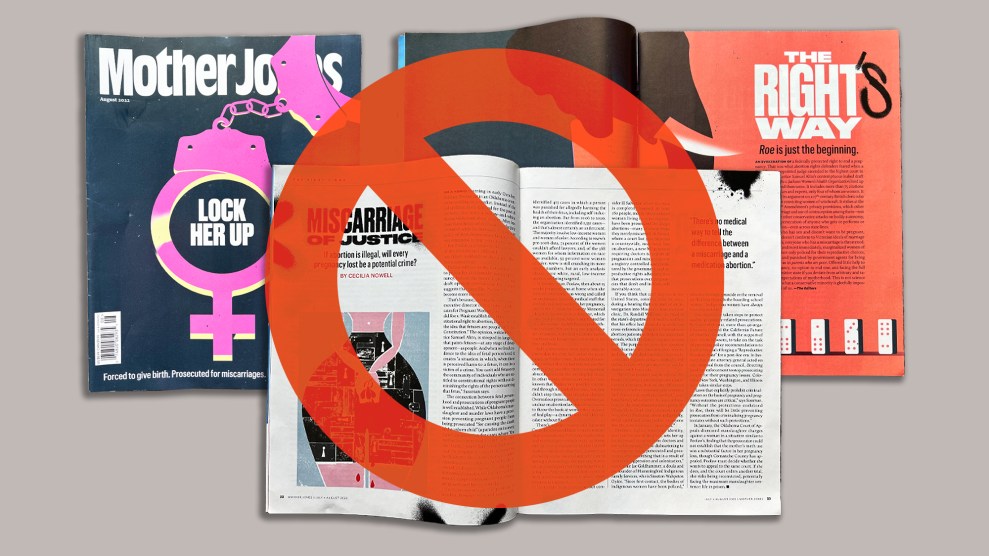
This October, a year and a half after the photos of prisoner abuse at Abu Ghraib horrified the world, the Pentagon released an upbeat press release announcing an art contest for the juvenile detainees at the facility. But stranger than the government’s flat-footed attempt at boosting its image is the fact that the gruesome images of Abu Ghraib have inspired virtually no genuine art. And that the American public, satisfied with the unremarkable punishments meted out to a few scapegoats, has seemingly forgotten that its government routinely tortures people.
Enter Fernando Botero, a 75-year-old Colombian painter often described as the most important living Latin American artist. Botero built his reputation with portraits of rotund Colombians engaged in ordinary activities. But for the 14 months after he read Seymour Hersh’s investigative report on Abu Ghraib in the May 10, 2004, New Yorker, Botero worked feverishly, ultimately creating a powerful set of portraits of the tortured. American critics have lauded the portraits since they were first shown in Europe, but a number of U.S. museums declined, without explanation, to show them before the University of California at Berkeley agreed to give them their first public exhibition in the country. Botero was at Berkeley on Monday for the opening, and participated in a public dialogue with Berkeley professor and former poet laureate Robert Hass.
Botero represents the Muslim detainees with the same corpulent bodies with which he represents everyday Latin Americans. The fleshy figures are surprisingly effective in the stark rooms of Abu Ghraib. The viewer expects to see those stocky bodies at a family picnic, which is a reminder that the detainees and torturers at Abu Ghraib also stepped into their roles fresh from everyday life. The victims’ corpulence gives Botero more room to suggest the suffering of the flesh. (He is a student of the masters.)
The paintings are big and are hung low in the makeshift library gallery Berkeley has provided. The broken men filling their frames cannot be ignored. They are naked, but for one who has been stuffed into red women’s panties. Gloved hands, boots, and dogs that look like medieval hounds from hell are the only sign of the torturers. The most incredible thing about the images is the subtlety of the victims’ injuries. The pulpy bruises and trickles of blood quietly attest to what has happened the moments and days before.
The elderly painter described his project modestly:
The more I read, the more I was motivated and angry, upset.…[I]n a plane going back to Paris,…I took paper and pencil and started doing some drawings. When I got to my studio in Paris, I kept drawing, and then painting. It became my obsession for 9 months…and finally I felt empty, like I didn’t have anything more to say.
Asked why he thought other artists had not responded to the horrors of Abu Ghraib, Botero explained, “When you are abstract or conceptual, it’s very difficult to express these feelings like I do in my work. Being a total figurative artist, I can do it. Perhaps there were other people who were working on this and who haven’t shown their work.”
The crowd in the overflowing Berkeley auditorium Monday afternoon wanted to cast Botero as an activist. One woman asked what he would think if protesters posed as his paintings in their weekly anti-torture vigil. The artist seemed baffled: “I doubt they’d leave the frame.” When Hass asked Botero how he would respond to conservatives’ demand to know why he didn’t paint the horrors of terrorism instead, he explained, “The countries that represent human rights, democracy—all of these things are part of the idea that America conveys. It was such a shock; it was something so unexpected.” But the artist had to laugh when a student asked why he chose dogs to represent the perpetrators, and Hass offered his own paraphrase, “When you were painting the dogs, did you feel like you were painting the heart of Dick Cheney?”
The artist, who ventured into political art once before with paintings of the ongoing bloody civil war in Colombia, has a clear sense of what art can and cannot do. He believes that “the greatest art cannot change anything,” but, he said, it “has the capacity to make us remember a situation for a long time—when the newspapers stop talking and the people stop talking, the art is there.” In the past, he has called art “a permanent accusation.” Botero’s paintings of Abu Ghraib may well serve as an influential reminder of the United States’ historic fall from grace.
The exhibit is on view in Room 190, Doe Library, Univ. of California Berkeley campus, through March 23, 2007. Exhibit hours are Monday – Thursday, 10:00 am – 7:00 pm, and Friday – Saturday, 10:00 am – 5:00 pm.






